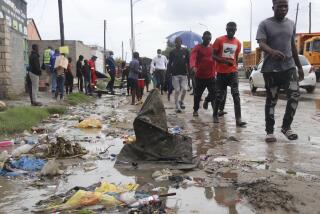Special Report: Seeking a New World : The AIDS Toll Is Growing Too Large to Ignore
- Share via
HARARE, Zimbabwe — It was the epidemic an entire country tried to ignore.
Earlier this year, Zimbabwe’s minister of health appeared before Parliament to announce that infection with the human immunodeficiency virus did not necessarily lead to AIDS. He already had declared that the strain of AIDS prevalent in Zimbabwe was non-lethal.
The government of Zimbabwe discouraged national testing for AIDS. Blood donors were not told if they were HIV-positive unless they asked. Ignorance was so prevalent that a rumor circulated in Harare this year that the cure for AIDS was raping a white woman.
Finally, the evidence became irrefutable. The number of confirmed AIDS cases in Zimbabwe jumped from 119 three years ago to 9,000 in September, with another 12,500 people known to be HIV-positive. Even more chilling, an unpublished analysis by Zimbabwe’s Central Statistical Office estimates that the nation’s future population eventually will be halved by the epidemic, from a potential 18 million in the year 2017 to only 8 million--fewer than live in the country today.
Zimbabwe is symptomatic of the terrible toll that AIDS is expected to inflict in Africa and in other developing areas, ranging from Haiti to the Philippines. The impact, however, will not be limited to deaths. The crippling side effects could end up shaping the future of many nations far more than traditional social and political events will. In some hard-hit nations, AIDS could become the central issue of the next decade.
“Today, AIDS is an issue of living or dying, of individual survival. Tomorrow, it may be an issue of nations surviving,” said a European envoy in Harare.
Since the most mobile segments of society tend to be the most vulnerable, groups pivotal to national security--most notably the military--could be ravaged. Officials in Zimbabwe acknowledge that up to 50% of the 46,000-man army is HIV-positive.
“At some point down the road, this country may not be able to protect itself from an external threat,” the European diplomat said. “More than half the army will have died off, and there won’t be the manpower to replace them. That is going to be a big problem throughout this region among unstable or insecure countries that have tribal or other disputes, either at home or with neighbors. It opens up some hideous possibilities.”
Meanwhile, the epidemic will wreak havoc with already troubled economies in developing nations. Because AIDS is most widespread among the 20-to-45 age group, the most productive strata of societies will be decimated in the 1990s.
“The economic and social impact of a disease that kills people in their most productive years will be immense,” said Dr. Michael H. Merson, director of the World Health Organization’s AIDS program. “The selective impact on young and middle-aged adults, who include business and government workers as well as members of social, economic and political elites, could lead to economic and even political destabilization in some developing countries.”
The dying generation will in turn leave behind a generation of orphans, creating an enormous welfare strain.
Since the cost of caring for AIDS patients in poor nations is prohibitive, any serious effort to take care of them will further drain national economies and set back development. In effect, African and other Third World countries are trapped in a no-win dilemma. If they use limited resources to treat people already condemned to die, they will have less for the education and development that are vital to both slowing the growth of AIDS and enabling countries to enter the 21st Century.
But as Zimbabwe eventually acknowledged--it replaced its health minister and launched its first anti-AIDS program--it is a dilemma that can no longer be ignored.
More to Read
Sign up for Essential California
The most important California stories and recommendations in your inbox every morning.
You may occasionally receive promotional content from the Los Angeles Times.













